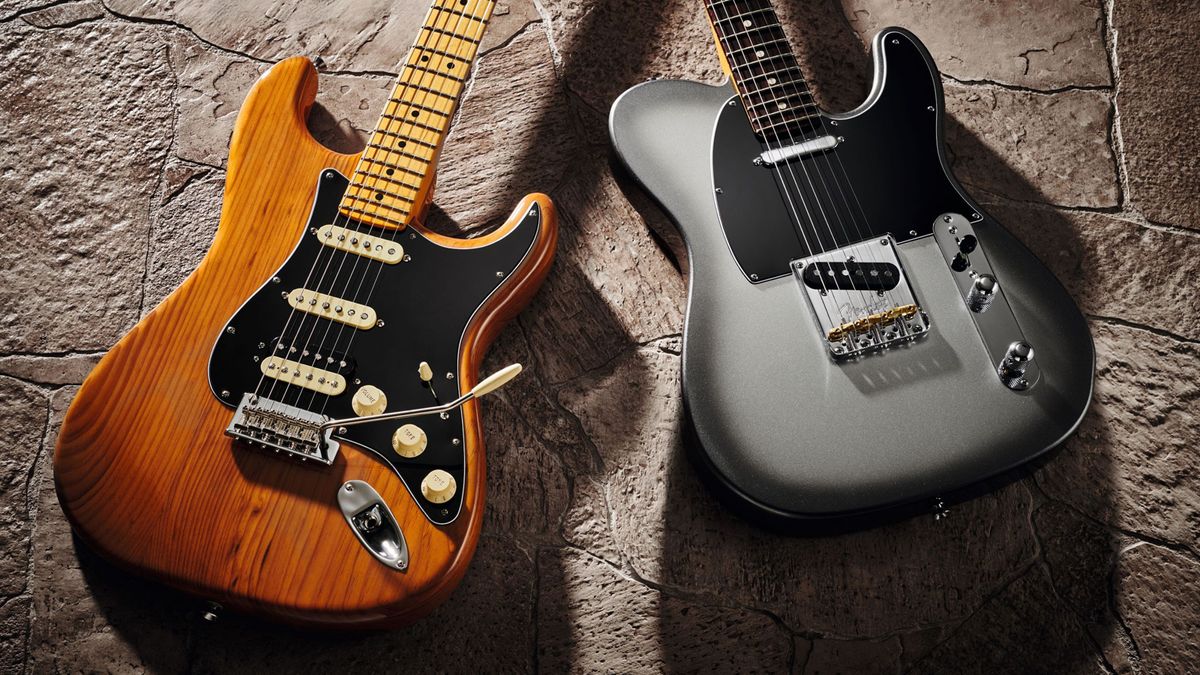Fender’s Telecaster and Stratocaster stand as iconic guitars, originating in the 1950s from a modest West-Coast-based manufacturer. As Fender evolved into the world’s leading guitar brand, the Tele and Strat cemented their status as industry mainstays, gracing countless stages.
Unlike many products that require constant innovation, the Tele and Strat, with minimal evolution, have preserved their distinctive qualities since their inception. This enduring similarity allows for easy recognition of their key characteristics and the factors that set them apart from each other.
In this feature, we delve into the history, the musicians, and the tones that differentiate these two guitars. Whether you’re considering a new Strat or Tele, we’ve highlighted some of our favorites and provided expert buying advice towards the end of the article.

Stratocaster vs Telecaster: The History
The Telecaster can be considered the forefather of today’s mass-manufactured solid-body guitars. Introduced in 1951, it didn’t gain immediate popularity but found its place among Western Swing players before branching into genres like country and rock ‘n’ roll.
Arriving three years later, the Stratocaster emerged from a sleek reimagining of Fender’s Precision Bass. It was designed as a more upscale instrument to follow the Telecaster and compete with the formidable Gibson Les Paul (released in 1952).
While the Telecaster retained its straightforward design, the Stratocaster introduced more tonal options with additional pickups and switching, along with a contoured body for enhanced comfort.
By the end of the ’50s, both guitars had become staples of the music scene, contributing significantly to the shift of popular music towards electric guitars, particularly in the rock ‘n’ roll genre.
Stratocaster vs Telecaster: The players
With around 70 years of use, both guitars boast an extensive list of users. While many renowned players have experimented with both, certain themes and styles often align with each.
The Tele, known for its robust tone, found favor with rock legends like Keith Richards and Jimmy Page. Strats, while versatile in rock, were favored by players seeking nuanced tones, including David Gilmour, Eric Clapton, and Jeff Beck.
Contemporary players, such as John Mayer, follow in the footsteps of Clapton and Beck, using a Strat for blues-based playing. Tele users span genres, from Pixies’ Black Francis and Radiohead’s Jonny Greenwood in alt-rock to Jason Isbell in country music.
Stratocaster vs Telecaster: Tones & sounds
The Telecaster, with its gritty workhorse reputation, typically features higher output pickups, including a distinctive bridge with a sharp bite. Its simple, solid design yields beautiful, sustained tones, and the higher output maintains clarity even at higher volumes.
The Stratocaster, distinguished by an extra pickup, unlocks a broader range of tonal options. Versions from 1977 onwards included a 5-way selector, allowing users to blend pickups for unique sounds and hum-cancellation.
The Strat’s neck pickup produces a warm, organic sound with a distinctive ‘bell’ quality, while the bridge pickup offers a nasal quality that complements distortion. The middle pickup combines clarity with a honky tonal character.

Stratocaster vs Telecaster: Buying advice
With both guitars having a history of around 70 years, countless references exist to help buyers choose the right sound. Investigating specific models used in favorite records can guide the selection of modern equivalents or reissues.
While numerous companies produce excellent versions of these guitars, it’s essential to listen to audio examples before buying off-brand products, especially at the entry level.
Considering the differences between the two, acquiring both a Tele and a Strat can be a rewarding addition to a guitarist’s collection. Budget-friendly options and a surplus of second-hand instruments make it accessible for enthusiasts to explore both pools without a significant financial commitment.
Stratocaster vs Telecaster: Our top picks
As Fender’s longest-standing and most beloved models, Telecasters and Stratocasters are available across every tier of Fender’s catalog. We’ve identified top picks for both, ranging from budget to top-line options.
Stratocaster Recommendations:
1. Squier Affinity Stratocaster: A solid example of a budget-friendly Strat with all the expected features, suitable for beginners or experts looking to add a Strat to their collection.
2. Fender Player Series Stratocaster: Positioned at the base of Fender’s offerings, it delivers genuine Fender quality without the cost of an American-made instrument. Notable improvements include upgraded hardware.
3. Fender American Professional II Series Strat: At the higher end, the Professional II Strat combines classic features with modern adjustments for exceptional tone and playability.
Telecaster Recommendations:
1. Squier Affinity Telecaster: Often sold as part of a set, this Tele is ideal for beginners due to its simple electronics. Advanced players can consider it as a project guitar for customization.
2. Fender Player Series Telecaster: Similar to its Strat counterpart, this Telecaster upgrades hardware compared to Squier siblings. It features Alnico V pickups for a classic Tele tone.
3. Fender American Professional II Series Tele: Offering features like the Strat version, the American Professional II Tele stands out for its attention to detail. Brass ‘Bullet’ saddles contribute to stable intonation and a vintage tone.
For those seeking the absolute best, Fender’s Custom Shop offers top-tier Stratocasters and Telecasters crafted by master luthiers. While these are at a premium price, the American Professional II series provides exceptional quality for those who prefer a more attainable option.


